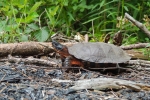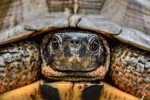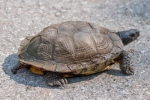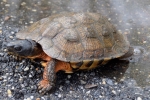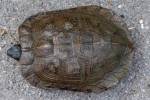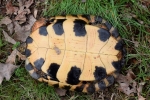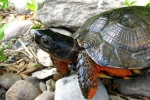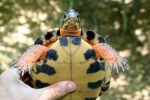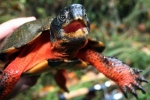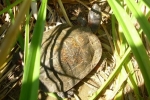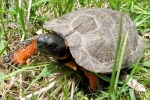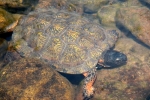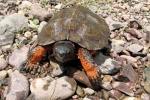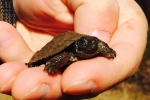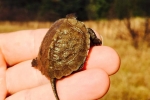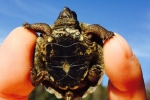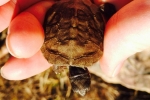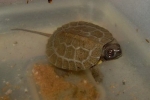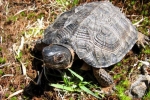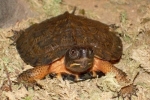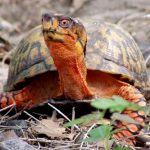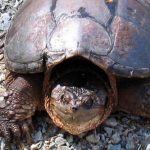Wood Turtle
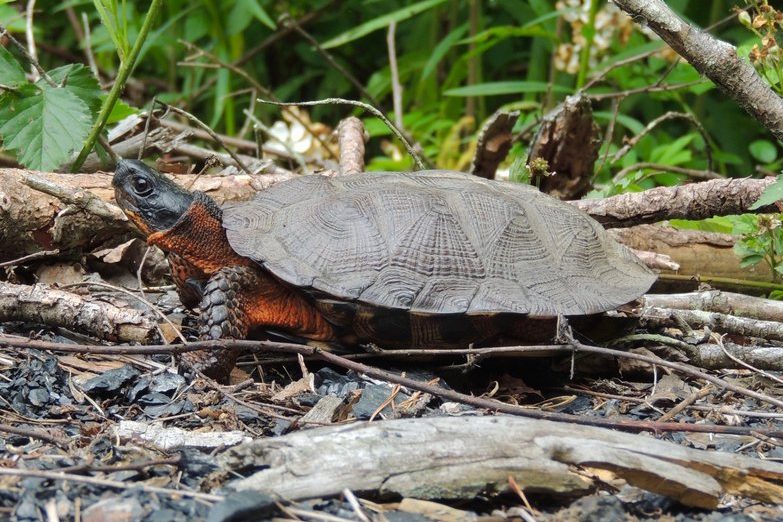
Scientific Name: Glyptemys insculpta
Size: (15-20 cm) in length
Status: Species of special concern
Habitat:
Open meadows, bogs, deciduous and coniferous forest, old fields, medium rivers, to small second-order streams.
Description:
Medium-sized semi-aquatic species. The upper shell is usually brown but sometimes gray. Often yellow and black lines can be seen on on the scutes. These lines appear to radiate outwards. The underside of the turtle is yellow with dark colored blotches. The skin of the turtle is dark when viewed from above, and bright orange or red when viewed from underneath. The shell is jagged and looks as if it each scute was hand carved.
- The carapace background color is greyish brown to brown with a series of yellow and black radiating lines on each side of the carapacial scutes.
- The plastron is yellow with oblong dark blotches on each scute.
- The marginals and bridge underneath have dark square blotches along the posterior outer corners of each scute.
- The skin of the head, neck, legs, and tail are dark brown to almost black dorsally, and bright red to orangish-red ventrally.
- The head may have faint speckled yellow dots.
- Medium-sized semi-aquatic species.
- Profile View – The carapace is low with a distinct middorsal keel.
- Above View – The carapace is elongate in outline with strong flaring posterior marginals and serrated.
- Growth rings give the carapacial scutes a raised, irregular pyramidal appearance.
- The plastron is large and smooth; the bridge is broad.
- The head and neck are large and flat.
- The upper jaw is strongly notched at the tip.
- The legs are well-developed and strong.
- The snout is non-projecting.
- The plastral scutes contain black squareish patches.
- The carapace is low in profile and almost circular in outline.
- Lacks the rough carapacial scutes.
- The posterior marginals are strongly flared.
- Extremely long tail.


References:
- Hulse, C. and McCoy C. J. and Ellen Censky ,1998. Amphibians and Reptiles of Pennsylvania and the Northeast. 210-215pp.
- Ernst, Carl H. and Lovich, Jeffrey E., and Barbour, Roger W. ,1994. Turtles of the United States and Canada. 222-233pp.
- Bob Hamilton
- Wayne Fidler
- Chris O’Neill
- Kyle Fawcett
- Stephen Staedtler
- Andy Weber
Heads up!
Please contribute your observation of this and other herps to the Pennsylvania Amphibian and Reptile Survey. Your help is needed.
